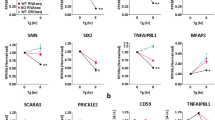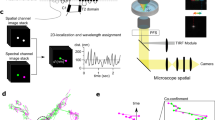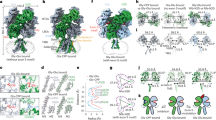Abstract
NRADD (neurotrophin receptor alike death domain protein) is a novel protein with transmembrane and cytoplasmic regions highly homologous to death receptors, particularly p75NTR. However, the short N-terminal domain is unique. Expression of NRADD induced apoptosis in a number of cell lines. The apoptotic mechanism involved the activation of caspase-8 and execution of apoptosis without requiring mitochondrial components. The activation of this death receptor-like mechanism required the N-terminal domain, which is N-glycosylated and needed for subcellular targeting. Deletion of the N-terminal domain produced a dominant-negative form of NRADD that protected neurons and Schwann cells from a variety of endoplasmic reticulum (ER) stressors. NRADD may therefore be a necessary component for generating an ER-induced proapoptotic signal.
Similar content being viewed by others
Log in or create a free account to read this content
Gain free access to this article, as well as selected content from this journal and more on nature.com
or
Abbreviations
- NRADD:
-
Neurotrophin receptor alike death domain protein
- ER:
-
Endoplasmic reticulum
- DD:
-
Death domain
- PI:
-
Propidium iodide
- FL:
-
Full length
- GFP:
-
Green fluorescent protein
- RFP:
-
Red fluorescent protein
- ER-YFP:
-
ER-targeted yellow fluorescent protein
References
Yuan J, Shaham S, Ledoux S, Ellis HM and Horvitz HR (1993) The C. elegans cell death gene ced-3 encodes a protein similar to mammalian interleukin-1β-converting enzyme. Cell 75: 641–652
Weber CH and Vincenz C (2001) The death domain superfamily: a tale of two interfaces? Trends Biochem. Sci. 26: 475–481
Martinon F, Hofmanndouble dagger K and Tschopp J (2001) The pyrin domain: a possible member of the death domain-fold family implicated in apoptosis and inflammation. Curr. Biol. 11: R118–R120
Locksley RM, Killeen N and Lenardo MJ (2001) The TNF and TNF receptor superfamilies: integrating mammalian biology. Cell 104: 487–501
Lee FS, Kim AH, Khursigara G and Chao MV (2001) The uniqueness of being a neurotrophin receptor. Curr. Opin. Neurobiol. 11: 281–286
Lee R, Kermani P, Teng KK and Hempstead BL (2001) Regulation of cell survival by secreted proneurotrophins. Science 294: 1945–1948
Wang X, Bauer JH, Li Y, Shao Z, Zetoune FS, Cattaneo E and Vincenz C (2001) Characterization of a p75NTR apoptotic signaling pathway using a novel cellular system. J. Biol. Chem. 276: 33812–33820
Kaufman RJ (1999) Stress signaling from the lumen of the endoplasmic reticulum: coordination of gene transcriptional and translational controls. Genes Dev. 13: 1211–1233
Bertolotti A, Zhang Y, Hendershot LM, Harding HP and Ron D (2000) Dynamic interaction of BiP and ER stress transducers in the unfolded-protein response. Nat. Cell. Biol. 2: 326–332
Urano F, Wang X, Bertolotti A, Zhang Y, Chung P, Harding HP and Ron D (2000) Coupling of stress in the ER to activation of JNK protein kinases by transmembrane protein kinase IRE1. Science 287: 664–666
Nakagawa T, Zhu H, Morishima N, Li E, Xu J, Yankner BA and Yuan J (2000) Caspase-12 mediates endoplasmic-reticulum-specific apoptosis and cytotoxicity by amyloid-beta. Nature 403: 98–103
Nakagawa T and Yuan J (2000) Cross-talk between two cysteine protease families. Activation of caspase-12 by calpain in apoptosis. J. Cell. Biol. 150: 887–894
Yoneda T, Imaizumi K, Oono K, Yui D, Gomi F, Katayama T and Tohyama M (2001) Activation of caspase-12, an endoplasmic reticulum (ER) resident caspase, through tumor necrosis factor receptor-associated factor 2- dependent mechanism in response to the ER stress. J. Biol. Chem. 276: 13935–13940
Rao RV, Hermel E, Castro-Obregon S, del Rio G, Ellerby LM, Ellerby HM and Bredesen DE (2001) Coupling endoplasmic reticulum stress to the cell death program: mechanism of caspase activation. J. Biol. Chem. 276: 33869–33874
Zinszner H, Kuroda M, Wang X, Batchvarova N, Lightfoot RT, Remotti H, Stevens JL and Ron D (1998) CHOP is implicated in programmed cell death in response to impaired function of the endoplasmic reticulum. Genes Dev. 12: 982–995
Majdan M, Lachance C, Gloster A, Aloyz R, Zeindler C, Bamji S, Bhakar A, Belliveau D, Fawcett J, Miller FD and Barker PA (1997) Transgenic mice expressing the intracellular domain of the p75 neurotrophin receptor undergo neuronal apoptosis. J. Neurosci. 17: 6988–6998
von Heijne G and Gavel Y (1988) Topogenic signals in integral membrane proteins. Eur. J. Biochem. 174: 671–678
Parodi AJ (2000) Role of N-oligosaccharide endoplasmic reticulum processing reactions in glycoprotein folding and degradation. Biochem. J. 348(Part 1): 1–13
Wang XZ and Ron D (1996) Stress-induced phosphorylation and activation of the transcription factor CHOP (GADD153) by p38 MAP Kinase. Science 272: 1347–1349
Kozutsumi Y, Segal M, Normington K, Gething MJ and Sambrook J (1988) The presence of malfolded proteins in the endoplasmic reticulum signals the induction of glucose-regulated proteins. Nature 332: 462–464
Kawai J, Shinagawa A, Shibata K, Yoshino M, Itoh M, Ishii Y, Arakawa T, Hara A, Fukunishi Y, Konno H, Adachi J, Fukuda S, Aizawa K, Izawa M, Nishi K, Kiyosawa H, Kondo S, Yamanaka I, Saito T, Okazaki Y, Gojobori T, Bono H, Kasukawa T, Saito R, Kadota K, Matsuda HA, Ashburner M, Batalov S, Casavant T, Fleischmann W, Gaasterland T, Gissi C, King B, Kochiwa H, Kuehl P, Lewis S, Matsuo Y, Nikaido I, Pesole G, Quackenbush J, Schriml LM, Staubli F, Suzuki R, Tomita M, Wagner L, Washio T, Sakai K, Okido T, Furuno M, Aono H, Baldarelli R, Barsh G, Blake J, Boffelli D, Bojunga N, Carninci P, de Bonaldo MF, Brownstein MJ, Bult C, Fletcher C, Fujita M, Gariboldi M, Gustincich S, Hill D, Hofmann M, Hume DA, Kamiya M, Lee NH, Lyons P, Marchionni L, Mashima J, Mazzarelli J, Mombaerts P, Nordone P, Ring B, Ringwald M, Rodriguez I, Sakamoto N, Sasaki H, Sato K, Schonbach C, Seya T, Shibata Y, Storch KF, Suzuki H, Toyo-oka K, Wang KH, Weitz C, Whittaker C, Wilming L, Wynshaw-Boris A, Yoshida K, Hasegawa Y, Kawaji H, Kohtsuki S and Hayashizaki Y, (2001) Functional annotation of a full-length mouse cDNA collection. Nature 409: 685–690
Scaffidi C, Fulda S, Srinivasan A, Friesen C, Li F, Tomaselli KJ, Debatin KM, Krammer PH and Peter ME (1998) Two CD95 (APO-1/Fas) signaling pathways. EMBO J. 17: 1675–1687
Coulson EJ, Reid K, Baca M, Shipham KA, Hulett SM, Kilpatrick TJ and Bartlett PF (2000) Chopper, a new death domain of the p75 neurotrophin receptor that mediates rapid neuronal cell death. J. Biol. Chem. 275: 30537–30545
Hempstead BL (2002) The many faces of p75NTR. Curr. Opin. Neurobiol. 12: 260–267
Baldwin AN and Shooter EM (1995) Zone mapping of the binding domain of the rat low affinity nerve growth factor receptor by the introduction of novel N-glycosylation sites. J. Biol. Chem. 270: 4594–4602
Rao RV, Castro-Obregon S, Frankowski H, Schuler M, Stoka V, del Rio G, Bredesen DE and Ellerby HM (2002) Coupling endoplasmic reticulum stress to the cell death program: an Apaf-1-independent intrinsic pathway. J. Biol. Chem. 27: 27
Nguyen M, Breckenridge DG, Ducret A and Shore GC (2000) Caspase-resistant BAP31 inhibits fas-mediated apoptotic membrane fragmentation and release of cytochrome c from mitochondria. Mol. Cell. Biol. 20: 6731–6740
Thomas PJ, Qu BH and Pedersen PL (1995) Defective protein folding as a basis of human disease. Trends Biochem. Sci. 20: 456–459
Imaizumi K, Miyoshi K, Katayama T, Yoneda T, Taniguchi M, Kudo T and Tohyama M (2001) The unfolded protein response and Alzheimer's disease. Biochim. Biophys. Acta. 1536: 85–96
Sato N, Urano F, Yoon Leem J, Kim SH, Li M, Donoviel D, Bernstein A, Lee AS, Ron D, Veselits ML, Sisodia SS and Thinakaran G, (2000) Upregulation of BiP and CHOP by the unfolded-protein response is independent of presenilin expression. Nat. Cell. Biol. 2: 863–870
Cattaneo E, Magrassi L, Butti G, Santi L, Giavazzi A and Pezzotta S (1994) A short term analysis of the behaviour of conditionally immortalized neuronal progenitors and primary neuroepithelial cells implanted into the fetal rat brain. Brain Res. Dev. Brain. Res. 83: 197–208
Brockes JP, Fields KL and Raff MC . (1979) Studies on cultured rat Schwann cells. I. Establishment of purified populations from cultures of peripheral nerve. Brain Res. 165: 105–118
Ausubel FM, Brent R, Kingston RE, Moore DD, Seidman JG, Smith JA and Struhl K (eds.) (1999) Current Protocols in Molecular Biology. New York: John Wiley & Sons, Inc.
Frankowski H, Castro-Obregon S, del Rio G., Rao RV and Bredesen DE (2002) PLAIDD, a type II death domain protein that interacts with p75 neurotrophin receptor. Neuro. Med. 1: 153–170
Acknowledgements
We thank Chris Weber for the sequence alignments. The ST14A cells were generously provided by Elena Cattaneo (University of Milano, Italy). We also thank James Russell for providing Schwann cells, Alnawaz Rehemtulla for ultraviolet radiation, and Yuseef Namy for help in preparing the figures. Junying Yuan generously provided the caspase-12 antibodies (Harvard Medical School). A-431 cells were provided by Yoram Milner (The Hebrew University-Jerusalem, Israel), and PC12 were from Lei Sun (University of Michigan). The work was supported by NIH ES08111 and DAMD 17-96-6085 grants.
Author information
Authors and Affiliations
Corresponding author
Additional information
Rights and permissions
About this article
Cite this article
Wang, X., Shao, Z., Zetoune, F. et al. NRADD, a novel membrane protein with a death domain involved in mediating apoptosis in response to ER stress. Cell Death Differ 10, 580–591 (2003). https://doi.org/10.1038/sj.cdd.4401208
Received:
Revised:
Accepted:
Published:
Issue date:
DOI: https://doi.org/10.1038/sj.cdd.4401208
Keywords
This article is cited by
-
The Endoplasmic Reticulum Stress Response in Neuroprogressive Diseases: Emerging Pathophysiological Role and Translational Implications
Molecular Neurobiology (2018)
-
NRH2 is a trafficking switch to regulate sortilin localization and permit proneurotrophin-induced cell death
The EMBO Journal (2009)
-
Caspase-12: an overview
Cell Death & Differentiation (2004)



